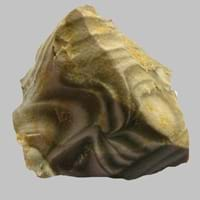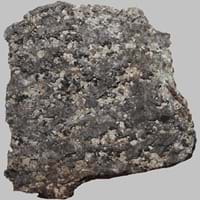Definition
Flint is a hard type of sedimentary rock that produces a small piece of burning material when hit by steel
Essexite which is also known as nepheline monzogabbro, is a dark gray or black holocrystalline plutonic Iigneous Rock
Discoverer
Unknown
Unknown
Etymology
From Old English flint - a type of rock mainly known for high hardness and for giving off sparks when struck
From the locality in Essex County, Massachusetts,US
Class
Sedimentary Rocks
Igneous Rocks
Sub-Class
Durable Rock, Hard Rock
Durable Rock, Hard Rock
Group
Not Applicable
Plutonic
Other Categories
Fine Grained Rock, Opaque Rock
Fine Grained Rock, Opaque Rock
Texture
Banded, Rough
Granular
Color
Black, Brown, Green, Grey, Red, White
Dark Grey to Black
Durability
Durable
Durable
Scratch Resistant
Yes
Yes
Appearance
Glassy or Pearly
Banded
Interior Uses
Decorative Aggregates, Homes, Interior Decoration
Decorative Aggregates, Homes, Interior Decoration
Exterior Uses
As Building Stone, As Facing Stone, Garden Decoration, Office Buildings, Paving Stone
As Building Stone, As Facing Stone, Garden Decoration, Office Buildings, Paving Stone
Other Architectural Uses
Curbing
Curbing
Construction Industry
Arrowheads, Cutting Tool, Spear Points
As Dimension Stone, Building houses or walls, Cement Manufacture, Construction Aggregate, for Road Aggregate
Medical Industry
Not Yet Used
Not Yet Used
Antiquity Uses
Artifacts
Artifacts, Monuments, Sculpture, Small Figurines
Commercial Uses
Creating Artwork, Gemstone, In fire-starting tools, Manufacture of tools, Metallurgical Flux, Jewelry, To ignite fire, Used in flintlock firearms
Cemetery Markers, Commemorative Tablets, Jewelry, Sea Defence, Tombstones
Types
Not Available
Not Available
Features
Clasts are smooth to touch, Easily splits into thin plates, Has High structural resistance against erosion and climate
Is one of the oldest rock, Smooth to touch
Archaeological Significance
Monuments
Not Yet Used
Used
Famous Monuments
Not Applicable
Data Not Available
Sculpture
Not Yet Used
Used
Famous Sculptures
Not Applicable
Data Not Available
Pictographs
Not Used
Not Used
Petroglyphs
Not Used
Not Used
Figurines
Not Yet Used
Used
Formation
Flint is formed by the decomposition and compaction of various organisms such as sponges and diatoms under the water.
Essexite is a type of igneous rock, which is usually dark grey to black plutonic rock. For the formation of essexite, suitable magma with exact composition of K, Ba, Rb, Cs, Sr should be produced.
Mineral Content
Silicon
Augite, Feldspar, Hornblende, Nepheline, Olivine, Plagioclase, Pyroxene
Compound Content
Silicon Dioxide
Aluminium Oxide, Ba, Ca, Cs, Potassium, Rb, Sodium, Sr
Types of Metamorphism
Not Applicable
Burial Metamorphism, Cataclastic Metamorphism, Contact Metamorphism, Hydrothermal Metamorphism, Impact Metamorphism
Types of Weathering
Not Applicable
Biological Weathering, Chemical Weathering
Types of Erosion
Chemical Erosion, Coastal Erosion, Water Erosion
Coastal Erosion, Glacier Erosion, Water Erosion
Grain Size
Very fine-grained
Fine Grained
Fracture
Conchoidal
Conchoidal
Porosity
Highly Porous
Highly Porous
Luster
Vitreous
Not Available
Compressive Strength
Not Available
Cleavage
Non-Existent
Not Available
Specific Gravity
2.5-2.8
Not Available
Transparency
Translucent to Opaque
Opaque
Density
2.7-2.71 g/cm3
Not Available
Specific Heat Capacity
Not Available
Resistance
Heat Resistant, Impact Resistant, Pressure Resistant, Wear Resistant
Impact Resistant, Pressure Resistant, Wear Resistant
Deposits in Eastern Continents
Asia
Azerbaijan, China, Russia
India, Russia
Africa
Not Yet Found
South Africa
Europe
Austria, Belgium, Cyprus, Denmark, France, Germany, Italy, Malta, Netherlands, Poland, Portugal, Romania, Spain, Sweden, Switzerland, Turkey, Ukraine, United Kingdom
Germany, Greece, Italy, Scotland, Turkey
Others
Not Yet Found
Greenland
Deposits in Western Continents
North America
USA
Canada, USA
South America
Bolivia
Brazil, Colombia, Venezuela
Deposits in Oceania Continent
Australia
New Zealand, South Australia
New Zealand, Queensland
All about Flint and Essexite Properties
Know all about Flint and Essexite properties here. All properties of rocks are important as they define the type of rock and its application. Flint belongs to Sedimentary Rocks while Essexite belongs to Igneous Rocks.Texture of Flint is Banded, Rough whereas that of Essexite is Granular. Flint appears Glassy or Pearly and Essexite appears Banded. The luster of Flint is vitreous while that of Essexite is not available. Flint is available in black, brown, green, grey, red, white colors whereas Essexite is available in dark grey to black colors. The commercial uses of Flint are creating artwork, gemstone, in fire-starting tools, manufacture of tools, metallurgical flux, jewelry, to ignite fire, used in flintlock firearms and that of Essexite are cemetery markers, commemorative tablets, jewelry, sea defence, tombstones.










